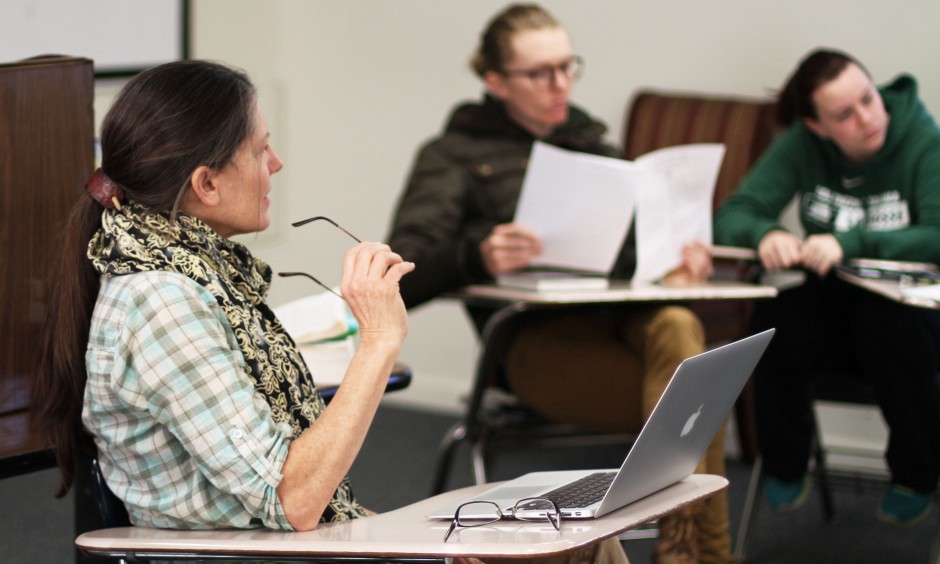Spotlight
Creativity, Core Values in the Classroom

Professor Jane Harrington first entered the world of children’s literature as she raised her own children. Not content to just read children’s books, she wrote her own, including “Extreme Pets!” and “My Best Friend, the Atlantic Ocean, and Other Great Bodies Standing Between Me and My Life with Giulio.” Now, she is sharing her expertise this semester as she teaches the university’s first course in children’s literature.
“From about 1996 till about 2008, I published children’s works, whether short pieces in magazines or in newspapers, or books,” she said. “So I spent a lot of time in the children’s literary world. I was a board member in the Children’s Book Guild of Washington when I lived up there, so I was very plugged into [that world]. … It’s an expertise I have, so I’m happy to [share] that.”
This is the first time the class has been offered, though Harrington said that it has been in the works for years. It is being offered as both an education and an English course. Because of the diversity of her students’ interests, Harrington is trying to make sure everyone’s needs are met.
“I’m experimenting, so [the students are] part of the process,” she said.
Each unit of the class — picture books, wonder tales and young adult — is capped with a project, which students can take “into a few different directions.”
“Students who want to try their hand at creative writing, they can do that,” she said. “Education students can create lesson plans for favorite books. Someone who wants to focus on literary analysis of favorite books or authors or illustrators can do that as well.”
Harrington holds a Master of Fine Arts in creative writing and is especially excited to be able to help students who wish to take the class in that direction, but she has also taught language arts to children and holds a master’s degree in the teaching of writing and literature. She said that she “feels that [she] can be useful to education students who are trying to present lesson plans.”
“I’m excited across the board,” she said. “[Children’s literature is] such an important part of childhood that I think it’s worth thinking about and analyzing, and the end result is that you are a better whatever you are — teacher, parent, anything, writer, academic.”
Harrington’s children’s literature course is just one of many special topics classes in Southern Virginia’s English program. Some classes have become so popular that they are now offered regularly.
Dr. Scott Dransfield, professor of English, first offered his Jane Austen class a decade ago as a summer elective, and he is now teaching two full sections of the upper-division course.
“There’s always a huge demand,” he said. “The Jane Austen fervor is not waning. It continues to build.”
He said that he felt inspired to teach Jane Austen because he believed her work is perfectly suited for the university.

“I almost feel duty-bound,” Dransfield said. “It’s something that I want to offer not just for my own interest, although I have interest, but because I do think that Jane Austen belongs at [Southern Virginia].”
Because of this “duty,” Dransfield has invested time in examining Austen and her place at Southern Virginia. After receiving the Elton Lectureship in 2013, he decided to pursue more Austen scholarship and examined the author, writing about Jane Austen and Southern Virginia’s core values of scholarship, discipleship, accountability, enthusiasm and refinement.
“It was about then that I determined, ‘I’ve got to do something more with Jane Austen. She really belongs here,’” he said.
Dransfield started offering the class during a traditional semester in spring 2014. He has now taught the class a number of times, partially because students request it, but also because he never tires of reading Austen’s work.
“Every time I teach the class, I experience the novels a little differently,” he said. When asked which novel is his favorite, he said that “Persuasion” is a long-time favorite, but “who knows what will happen this time.”
He also wants to ensure that students find in Austen all that he sees in her.
“I want them to be convinced that she is a great writer,” he said. “You can make a good movie, there are good stories, but I want them to see that she was an expert storyteller. That is to say, she was very much a master of her art, the art of narrative.”
These qualities are behind Dransfield’s academic interest in Austen and his enjoyment of her work, but he said that the core values present in her novels are what truly make her a Southern Virginia staple.
“[The core values] are virtues that become crucial at some point in the novels,” Dransfield said. “It comes down to the [fact that Austen’s] novels explore these values as being important and crucial to a good life. So, the novelist’s interests are our interests, and I think she places the same kind of value on the things that we place value on, but it’s done through brilliant stories, that, like Samuel Johnson said, ‘teach better than precept.’”
Rebekah Taylor, a senior taking Dransfield’s class, said that she has learned more from the class than she had anticipated — about Austen and about the world around her.
“I’ve loved Jane Austen for as long as I can remember loving any author, so I was really excited when I found out that I could take a Jane Austen class,” Taylor said. “More and more I’m realizing that Jane Austen was a brilliant observer of people and of human nature, and I feel like I understand myself and other people better because I’m able to study her writings.”
 News
News